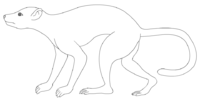Plesiadapidae
| Plesiadapidae | |
|---|---|

| |
| Plesiadapis | |
| Scientific classification | |
| Kingdom: | |
| Phylum: | |
| Class: | |
| Infraclass: | |
| Superorder: | |
| Order: | |
| Superfamily: | |
| Family: | †Plesiadapidae Trouessart, 1897
|
| Genera | |
|
†Pronothodectes | |
| Synonyms | |
|
Plesiadapinae Trouessart, 1897 | |
Plesiadapidae is a family of plesiadapiform mammals related to primates known from the Paleocene and Eocene of North America, Europe, and Asia.[1][2] Plesiadapids were abundant in the late Paleocene, and their fossils are often used to establish the ages of fossil faunas.[3]
Classification
McKenna and Bell[1] recognized two subfamilies (Plesiadapinae and Saxonellinae) and one unassigned genus (Pandemonium) within Plesiadapidae. More recently Saxonella (the only saxonelline) and Pandemonium have been excluded from the family,[4] leaving only a redundant Plesiadapinae. Within the family, Pronothodectes is the likely ancestor of all other genera, while Plesiadapis may be directly ancestral to both Chiromyoides and Platychoerops.[3]
Popular culture
This mammal features in the novel Evolution written by Stephen Baxter.
References
- ^ a b McKenna, M. C, and S. K. Bell (1997). Classification of Mammals Above the Species Level. Columbia University Press. ISBN 023111012X.
{{cite book}}: CS1 maint: multiple names: authors list (link) - ^ Thewissen, J.G.M., Williams, E.M., and Hussain, S.T. (2001). "Eocene mammal faunas from northern Indo-Pakistan". Journal of Vertebrate Paleontology. 21 (2): 347–366. doi:10.1671/0272-4634(2001)021[0347:EMFFNI]2.0.CO;2.
{{cite journal}}: CS1 maint: multiple names: authors list (link) - ^ a b Gingerich, P.D. (1976). "Cranial anatomy and evolution of early Tertiary Plesiadapidae (Mammalia, Primates)". University of Michigan Papers on Paleontology. 15: 1–141.
- ^ Silcox, M.T., Krause, D.W., Maas, M.C., and Fox, R.C. (2001). "New specimens of Elphidotarsius russelli (Mammalia, ?Primates, Carpolestidae) and a revision of plesiadapoid relationships". Journal of Vertebrate Paleontology. 21 (1): 132–152. doi:10.1671/0272-4634(2001)021[0132:NSOERM]2.0.CO;2.
{{cite journal}}: CS1 maint: multiple names: authors list (link)
